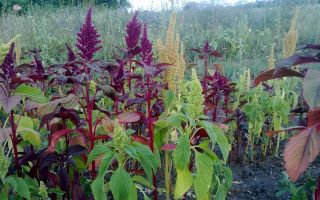Content
- 1 What does amaranth look like and where does it grow?
- 2 Chemical composition and calorie content of amaranth
- 3 The healing properties of amaranth
- 4 The benefits of amaranth for pregnant women and children
- 5 Is amaranth good for weight loss
- 6 Traditional medicine recipes with amaranth
- 7 The use of amaranth in cooking
- 8 Why are sprouted amaranth seeds useful?
- 9 Benefits of amaranth bran
- 10 Amaranth meal: benefit and application
- 11 How amaranth is used in cosmetology
- 12 Amaranth harm and contraindications
- 13 Conclusion
- 14 Reviews
Amaranth is a medicinal herb that has been known since the Mayan and Aztec civilizations. A person uses all the parts of the shrimp: stems, leaves, roots and seeds. The benefits and harms of amaranth have long been studied, so it is used in cooking, cosmetology, and medicine. The plant strengthens the immune system and has anti-tumor properties.
What does amaranth look like and where does it grow?
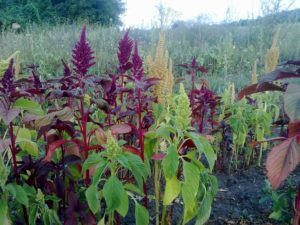
Amaranth or shiritsa, velvet, cockscomb is a herbaceous plant. Differs in a branched stem about 1 m long. It can be annual and perennial. Leaves are oblong, pointed, green, less often red. It blooms with purple-red panicles, from 0.2 m to 0.5 m long. At the end of August, seeds with a dense skin ripen in small capsule fruits.
It grows in warm temperate climates. Her homeland is South America. The amaranth family consists of more than 100 plant species, divided into forage, vegetable and ornamental plants. About 20 species are found in Russia. Until the 18th century, amaranth was grown in Europe as an ornamental crop, and later they appreciated its usefulness as livestock feed and for the production of cereals. Today it can be found in the wild in India and China.
The chemical composition and calorie content of amaranth
In the amaranth plant, the benefits and harms are due to a unique combination of nutritional and vitamin-mineral agents. Thanks to chemical research, the composition of the squid was determined:
- vitamins A (146 μg), C (43.3 mg), B1 (0.03 mg), B2 (0.16 mg), B5 (0.06 mg), B6 (0.19 mg), B9 (85 μg), PP (0.66 mg), K (1140 μg);
- trace elements iron (2.32 mg), zinc (0.9 mg), selenium (0.9 mg), manganese (0.89 mg), copper (0.16 mg);
- macronutrients calcium (215 mg), phosphorus (50 mg), magnesium (55 mg), potassium (611 mg), sodium (20 mg);
- amarantine (water-soluble antioxidant);
- polyphenols and flavonoids (16%);
- amino acids (15%), including lysine, useful for the body in the production of hormones, enzymes, anti-inflammatory antibodies, in the work of the cardiovascular system and tryptophan, which affects metabolic processes;
- protein (21%);
- dietary fiber (34%);
- vegetable oils, including polyunsaturated fatty acids Omega-3 and Omega-6 (9%);
- squalene (11%) - stops the reproduction of cancer cells, has a regenerating and immunostimulating properties;
- pectin;
- starch (60%);
- lipids (85%);
- phytosterols;
- betacyanin pigments.
Both seeds and leaves are useful.
Nutritional value of 100 g of lard:
- proteins - 13.56 g;
- carbohydrates - 68.55 g;
- fats - 7.02 g;
- fiber - 6.7 g;
- ash - 2.88 g;
- calorie content - 371 kcal.
This plant is recommended for daily consumption by the World Health Organization.
The healing properties of amaranth
In medicine, the useful composition of the amaranth plant is used for the prevention and treatment of the following diseases and problems:
- lowering cholesterol levels with phytosterols;
- treatment of hypertension and coronary heart disease;
- prevention of osteoporosis due to the presence of calcium, magnesium and phosphorus;
- treatment of calcium deficiency;
- normalization of metabolism;
- prevention of the development of heart and vascular diseases;
- reducing harm from the growth of cancer cells;
- treatment of cataracts, blepharitis, conjunctivitis, night blindness;
- stimulating the brain - a property of zinc and vitamin B;
- respiratory tract diseases;
- treatment of bleeding gums;
- skin diseases, including eczema.
The benefits of amaranth for the human body are not limited to the listed list of properties. The balanced content of vitamins and elements in different parts of the plant makes amaranth useful in dietary nutrition. At the same time, the harm of mono-diets in sports nutrition is reduced, muscle growth is stimulated.
Why are amaranth leaves useful?
From the leaves of the plant, juice is obtained, which is drunk in 1 tbsp. l. adults and 1 tsp. children - in such an amount of harm, no one will be. As a source of natural protein, it is useful in baby food. The juice has medicinal properties and helps patients with tuberculosis, bronchitis, asthma. The leaves are rich in amino acids: threonine, cystine, methionine, phenylalanine, leucine. Constant use will enrich the body with useful substances and will have a beneficial effect due to the properties of the plant:
- strengthening of immunity;
- normalization of hormonal levels;
- protection against fungal infection;
- stimulation of the reproductive system;
- anti-inflammatory and analgesic properties;
- stimulation of insulin production;
- improving the functioning of the respiratory and cardiovascular systems;
- temperature normalization.
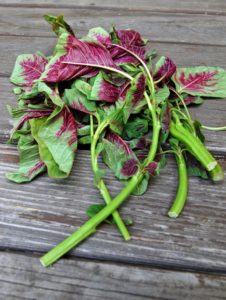
Benefits of amaranth seeds
Regular consumption of ambergris seeds is beneficial for reducing pain and normalizing menstrual periods in women. During menopause, it will help to maintain normal hormonal levels. Men benefit from the property of improving potency, as well as in the treatment of prostatitis.
Athletes eat amaranth seeds for:
- acceleration of muscle growth during recovery of the body after intensive physical training,
- development of endurance,
regulation of acid and water balance without harming the body.
Helpful in treating calcium and vitamin D deficiencies. Uncontrolled consumption can be harmful or cause an allergic reaction. Diabetics appreciate the plant seeds' ability to lower blood glucose levels.
The benefits of amaranth seeds are noticeable for the whole body. It calls:
- improving digestion;
- removal of toxins and toxins;
- support of the liver and adrenal glands;
- beneficial effect on the nervous system;
- normalization of pressure.
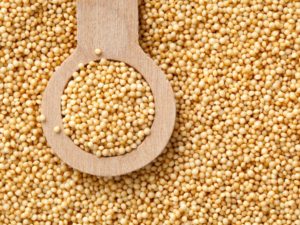
The benefits of amaranth for pregnant women and children
Shiritsa is good for pregnant women and babies. The leaves and seeds contain a lot of folic acid. This vitamin is especially beneficial during the first weeks of pregnancy. Its deficiency harms the formation and development of the child's brain and spinal cord.
Children are given 1 tsp daily. amaranth juice with a drop of honey. This dose contains the daily protein intake. The reception of the squid stimulates the growth and development of children, becomes a guarantee of their health.
Is amaranth good for weight loss
A number of studies have confirmed the benefits of using amaranth in the fight against excess weight. Derivatives are used as components of different diets:
- salad dressing oil;
- bran is useful for speeding up metabolism;
- flour for baking does not harm the figure;
- meal or cake are useful as a source of protein;
- tea and flakes from the squid.
Amaranth goes well with other products and complements any dish with a sufficient amount of nutrients, since the main thing in any diet is a balanced diet.
Traditional medicine recipes with amaranth
The Indians were the first to appreciate the beneficial properties of the herb. Amaranth is prized in folk medicine for its antibacterial, hemostatic and anti-inflammatory properties. Seeds and leaves have a tonic effect, are able to fully provide the body with all the necessary vitamins, macro- and microelements. Self-medication with amaranth can be harmful to health. Therefore, you need to consult your doctor.
Amaranth oil is a great source of vitamins and acids. It has a pronounced anti-inflammatory property and is actively used both in medicine and in cosmetology.
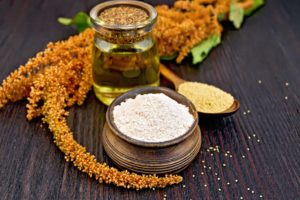
Amaranth broth
The main component is a plant mixture (dried crushed leaves, roots and amaranth flowers). Fresh, finely chopped roots are just as useful.
You need to fill in 2 tbsp. l. mixture (about 15 g) 200 ml of boiling water, boil for 10 minutes over low heat. The broth is cooled and filtered. Take half a glass three times a day half an hour before meals. It has a tonic effect. Improve the taste of 1 tsp. honey and ½ tsp. lemon juice.
Infusion of amaranth
The classic infusion is prepared from 1 tbsp. l. chopped amaranth leaf and 1 tbsp. water. It is boiled in a water bath for a minute, then boiled water is added to its original volume.
Take 2 sips chilled 30 minutes before meals for 2 weeks for gastrointestinal tract treatment. Gums are rinsed using anti-inflammatory properties. Tampons with an infusion of scythe will relieve menstrual syndrome, are useful for the prevention of ovarian cysts.
Fresh leaves are used to prepare a remedy for diseases of the genitourinary system, enuresis. For this, 3 tbsp. l. 1 liter of boiling water is poured into finely chopped leaves for 6 hours. Take a glass before going to bed.
Amaranth bath
The anti-inflammatory and regenerating properties of the plant are used in the treatment of insect bites, burns, bedsores and skin diseases. They take baths with shiritsa 3 times a week for half an hour. They are harmful to people with exacerbation of pancreatitis, urolithiasis, and cholecystitis.
For cooking in a water bath, boil 400 g of chopped leaves and stems in 2 liters of water for 15 minutes. The mixture is filtered and poured into a full bath.
Amaranth tea
It is caffeine-free, so there will be no harm from frequent use. There is a noticeable benefit as an additional agent in the treatment of the body from:
- diabetes mellitus;
- anemia;
- painful menstrual syndrome;
- lactation problems;
- arthritis, arthrosis and ostechondrosis;
- insomnia, nervous system disorders;
- acute and chronic respiratory diseases;
- for weight loss.
To make healthy tea, you need to pour 1 tbsp. l. dry or fresh leaves and inflorescences of amaranth and ½ tsp. mint 100 ml hot water (~ 80 ° C), leave in a closed kettle for 7 minutes. Then add another 100 ml of boiling water and a spoonful of honey for a more pleasant taste.
The use of amaranth in cooking
Despite its unusual taste, amaranth is an indispensable ingredient in the kitchen. The benefits of even a small supplement are very noticeable. Amaranth is eaten in the form of:
- Salads and soups made from plant leaves. They are pre-poured with boiling water or boiled.
- Salad dressing based on amaranth oil. Frying on it is not worth it - when heated, useful substances turn into harmful carcinogens.
- Baking and sweets. They are prepared with the addition of seeds, flour, bran.
- Side dish. Amaranth seed porridge is healthier than rice or pasta.
- Peruvian beer.
The benefits and recipe of amaranth porridge
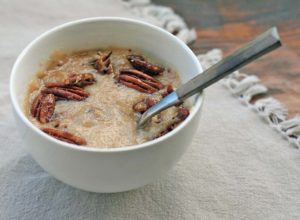
Scientists have confirmed the benefits of amaranth cereal when consuming porridge for one month. It exhibits anti-inflammatory properties on the liver and gallbladder, normalizes the intestinal microflora and promotes the removal of toxins, strengthens the immune system.There is no harm from gluten in the product, so porridge can be given even to babies, after consulting a pediatrician.
Easy to prepare:
- Grain and water (or milk) are taken in a ratio of 1 to 3.
- Amaranth is added to boiling water.
- Stir the porridge until the seeds settle.
- Cover and leave for 40 minutes. Shiritsa will explode when heated. Check the water level periodically, top up if necessary.
The porridge is tender and with a slight nutty flavor. It can be made healthier with a pinch of cinnamon, dried fruit, nuts, or honey.
Why are sprouted amaranth seeds useful?
Amaranth sprouts bring benefits to the whole body. It is a valuable source of energy. Eating germinated seeds at night is harmful - there is a high probability of overexcitation and insomnia. It is taken for medicinal purposes regularly or in courses of 2 months with a break of 6 months for prevention. The benefits are manifested in anti-tumor properties. Substances in the sprouts of the shrimp harm cancer cells, inhibiting their reproduction.
Germinate the seeds in a glass container on ¾ covered with water in a bright place, without direct sunlight. The benefits of sprouted amaranth for the body are noticeable both from fresh sprouts and when stored in the refrigerator.
Benefits of amaranth bran
The peel of the seeds contains much more nutrients than the kernels. And of all the bran of grain crops, amaranths are considered the best, since they simultaneously contain in large quantities:
- dietary fiber (97%);
- unsaturated fats;
- amino acids;
- vitamins of group B, PP and E;
- magnesium, calcium, potassium, iron, phosphorus and sodium.
Their use is irreplaceable as a source of fiber. Dietary fiber has the ability to bind and remove toxins from the digestive tract. Amaranth normalizes metabolic processes, lowers cholesterol levels, and removes excess weight. Without harm to the body, you can eat 40-50 g of bran per day.
Amaranth meal: benefit and application
Squeezing oil from amaranth seeds gives meal - small particles. It is used in medicine as an anti-inflammatory, cleansing, anti-sclerotic, firming and anti-cancer agent.
The meal is useful for pregnant and lactating women. It is harmless when breastfeeding, is rich in fiber, and helps relieve constipation. Its property of increasing lactation is appreciated.
How amaranth is used in cosmetology
Amaranth oil is useful for skin beauty. Two drops are added harmlessly to skin and hair care products. At this concentration, the plant has the following properties:
- rejuvenating and tightening the skin;
- protective from external stimuli;
- hydration and nutrition;
- evens out the tone of the face;
- strengthens nails and hair.
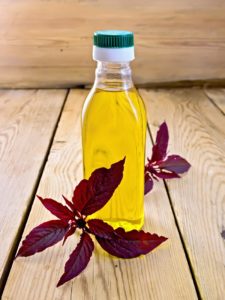
Mask for the face
Masks are effective treatments for the skin. They can be prepared from amaranth with the following properties:
- Moisturizing mask for dry skin. Mix 1 tbsp. l. amaranth oil, honey, 1 egg yolk.
- Prevention of acne. For 30 minutes, apply a 2 tbsp. l. amaranth oil, 2 tbsp. l. orange juice and ½ tsp. lemon juice.
- For peeling skin, apply a mask of sour cream and oil in a ratio of 3 to 2 for 15 minutes.
- For tightening pores and deep cleaning. A mixture of 1 part clay and 2 parts oil is applied to warm skin for 15 minutes. After the procedure, wash with warm water.
Lotion
The simplest lotion is freshly squeezed amaranth juice. To preserve its properties, it is stored in a glass container in a refrigerator. Infusion lotion is prepared from 1 tbsp. l. dry leaf or 2-3 tbsp. l. fresh leaves. The plant is poured with 250 ml of boiling water and left for 1–1.5 hours. After filtering. It is useful to wipe the skin of the face and neck with it twice a day.
Amaranth for hair beauty
The broth from the leaves of the squid belongs to the conditioners. To strengthen hair, amaranth is used 1-2 times a week. To prepare the broth, insist 3 tbsp. l. dry leaves in 1 liter of boiling water during the day. Before use, dilute with warm water in a 1 to 1 ratio.
Amaranth oil is useful as a remedy for hair loss. A few drops of oil are rubbed into the scalp at night for 2-6 months.Before the first use, you need to make a test on any part of the skin to make sure that there is no harm to the body - allergies.
Amaranth harm and contraindications
Almost everyone can use the plant. It will bring harm if there is:
- individual intolerance, allergy to any component;
- stones in the kidneys and gallbladder;
- pancreatitis;
- cholecystitis.
Amaranth is introduced into the diet in small doses. In order for treatment with drugs from the plant to be beneficial, not harmful, it is recommended to consult a doctor.
Conclusion
The benefits and harms of amaranth are incomparable. This plant has many medicinal properties due to its unique chemical composition. Taking it regularly will help maintain your beauty and health for years to come.

